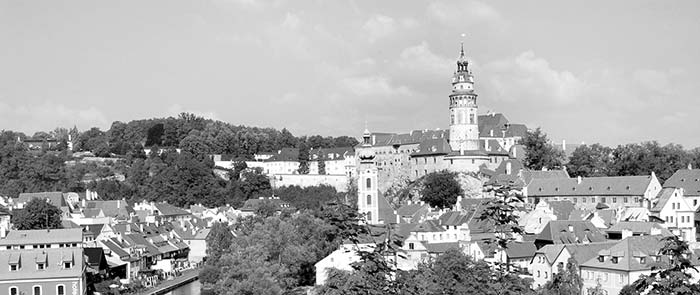
Krummau
BETWEEN THE BUS STATION AND THE OLD TOWN
Surrounded by mountains, lassoed by its river, and dominated by its castle, this enchanted town mesmerizes visitors. When you see its awe-inspiring castle, delightful Old Town of cobbled lanes and shops, and easy canoeing options, you’ll understand why having fun is a slam-dunk here. Romantics are floored by its spectacular setting; you could spend all your time doing aimless laps from one end of town to the other.
The sharp bends in the Vltava provide natural moats, so it’s no wonder Český Krumlov has been a choice spot for eons. Celtic tribes settled here a century before Christ. Then came Germanic tribes. The Slavic tribes arrived in the ninth century. The Rožmberks (Rosenbergs)—Bohemia’s top noble family—ran the city from 1302 to 1602. You’ll spot their rose symbol all over town.
The 16th century was the town’s Golden Age, when Český Krumlov hosted artists, scientists, and alchemists from across Europe. In 1588, the town became home to an important Jesuit college. In 1602, the Rožmberks ran out of money to fund their lavish lifestyles, so they sold their territory to the Habsburgs—who ushered in a more Germanic period. After that, as many as 75 percent of the town’s people were German—until 1945, when most Germans were expelled (for more on this era and its repercussions, see the sidebar on here).
Český Krumlov’s rich mix of Gothic, Renaissance, and Baroque buildings is easy to miss. As you wander, be sure to look up...notice the surviving details in the fine stonework and pretty gables. Step into shops. Snoop into back lanes and tiny squares. Gothic buildings curve with the winding streets. Many precious Gothic and Renaissance frescoes were whitewashed in Baroque times (when the colorful trimmings of earlier periods were way out of style). Today, these frescoes are being rediscovered and restored.
Český Krumlov is a huge tourist magnet, which makes things colorful and easy for travelers. At times it can feel like a medieval theme park—but fortunately there are still hidden nooks and sleepy back alleys to make the place feel genuine.
It’s easy to enjoy Český Krumlov without ever paying to enter a sight (morning and evening are best for strolling without crowds). But a tour of the Baroque Theater at the castle is worth considering: If you want to join an English tour, sign up first thing in the morning (call ahead or visit in person), then build your day around your visit time. While you're at it, consider booking an English tour of the castle interior. Those who hate planning ahead on vacation can join a Czech tour of the theater or castle anytime (English information sheets provided). And visits to the newly restored synagogue and Seidel Photo Studio Museum bring more recent history alive.
A paddle down the river to Zlatá Koruna Abbey is a highlight (three hours), and a 20-minute walk up to the Křížový Vrch (Hill of the Cross) rewards you with a fine view of the town and its unforgettable riverside setting.
Many sights are closed on Monday, though the major attraction—the town itself—is always open. Evenings are for atmospheric dining and drinking.
Český Krumlov (CHESS-key KROOM-loff) means, roughly, “Czech Bend in the River.” Calling it “Český” for short sounds silly to Czech speakers (since dozens of Czech town names begin with “Český”)—rather, they call it “Krumlov.”
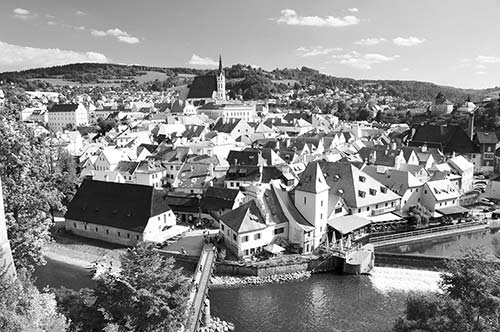
The city is extremely easy to navigate. The twisty Vltava River, which makes a perfect S through the town, ropes the Old Town into a tight peninsula. Above the Old Town is the Castle Town. Český Krumlov’s one main street starts at the isthmus and winds through the peninsula, crossing a bridge before snaking through the Castle Town, the castle complex (a long series of courtyards), and the castle gardens high above. I've narrated this route on my self-guided walk. The main square, Náměstí Svornosti—with the TI, ATMs, and taxis—dominates the Old Town and marks the center of the peninsula. All recommended restaurants, hotels, and sights are within a few minutes’ walk of this square.
The helpful TI is on the main square (daily 9:00-18:00, June-Aug until 19:00, shorter hours in winter, tel. 380-704-622, www.ckrumlov.info). The 129-Kč City Guide book includes a fine town and castle map. The TI has a baggage-storage desk and can check train and bus schedules. Ask about concerts, city walking tours in English, and canoe trips on the river. They rent an audioguide featuring a self-guided town walk (100 Kč, one hour). A second, less-crowded TI—actually a private business—is in the lowest courtyard of the castle (daily 9:00-18:00, tel. 380-725-110).
Český Krumlov Card: This 200-Kč card, sold at the TI and participating sights, covers entry to the Round Tower, Castle Museum (but not castle tours), Museum of Regional History, and Seidel Photo Studio Museum. Do the math to decide if it makes sense for you.
By Train: The train station is a 20-minute walk from town (turn right out of the station, then walk downhill onto a steep cobbled path leading to an overpass into the town center). Taxis are standing by to zip you to your hotel (about 100 Kč), or call 602-113-113 to summon one.
By Bus: The bus station is just three blocks away from the Old Town. To walk from the bus-station lot to the town center, follow the “walking man” signs out of the lot to Centrum, veer right and downhill on the small road, and cross the main road past the Co-op grocery. Figure on 60 Kč for a taxi from the station to your hotel.
By Car: Parking lots ring the town center, each one marked by a blue P sign. If your hotel is in the mostly traffic-free center, you'll be allowed to drive in (gingerly passing hordes of tourists) and park on the main square just long enough to drop off your bags and get directions to one of the outer lots. The flow of traffic is one-way: Enter at the east end of town, on Horní street, then exit across two bridges at the south end of town, on Linecká street (get details from your hotel before you arrive).
Exchange Rate: 25 Kč = about $1
Country Calling Code: 420 (see here for dialing instructions)
Festivals: Locals drink oceans of beer and celebrate their medieval roots at big events such as the Celebration of the Rose (Slavnosti Růže), where blacksmiths mint ancient coins, jugglers swallow fire, mead flows generously, and pigs are roasted on open fires (late June, www.ckrumlov.info). The summer also brings a top-notch international music festival, with performances in pubs, cafés, and the castle gardens (mid-July-mid-Aug, www.festivalkrumlov.cz). During St. Wenceslas celebrations, the square becomes a medieval market and the streets come alive with theater and music (late Sept). Reserve a hotel well in advance if you’ll be in town for these events.
Bike Rental: You can rent bikes at the train station (150 Kč/day with train ticket, prices slightly higher otherwise, tel. 380-715-000), Vltava Sport Service (see listing under “Canoeing and Rafting the Vltava” on here), and the recommended Hostel 99.
Since the town itself, rather than its sights, is what it’s all about here, taking a guided walk is the key to a meaningful visit. The TI sells tickets for several different guided walks. No reservations are necessary—just meet in front of the TI on the main square and pay the guide. Confirm times when you visit, as schedules can change. The Old Town Tour offers the best general town introduction (300 Kč, daily at 12:30, 1.5 hours); in peak season, this tour extends to include the castle exteriors (490 Kč, April-Oct daily at 14:30). There’s also a nighttime version (departing between 19:30 and 20:30, depending on the season). For a self-guided town walk, consider the TI’s audioguide (see "Tourist Information," earlier).
Oldřiška Baloušková studied in California before starting a family back in her hometown, which she knows through and through (500 Kč/hour, mobile 737-920-901, oldriskab@gmail.com). Jiří (George) Václavíček, a gentle and caring man who perfectly fits mellow Český Krumlov, is a joy to share this town with (500 Kč/hour, mobile 603-927-995, www.krumlovguide.com, jiri.vaclavicek@gmail.com). Karolína Kortušová is an enthusiastic, experienced guide with great organizational skills. Her company, Krumlov Tours, can set you up with a good local tour guide, palace and theater admissions, river trips, and more (guides-500 Kč/hour, mobile 723-069-561, http://krumlovtours.com, info@krumlovtours.com).
The town’s best sight is its cobbled cityscape, surrounded by a babbling river and capped by a dramatic castle. Most of Český Krumlov’s modest sights are laced together in this charming self-guided walk from the top of the Old Town, down its spine, across the river, and up to the castle. The walk begins at a fine viewpoint...and ends at an even better one. I've divided it into two parts: downhill, through the Old Town to the river; then uphill, ascending through the castle complex on the other side. You can also do the two parts on different days. The second half of the walk makes a useful spine for organizing a visit to the castle quarter.
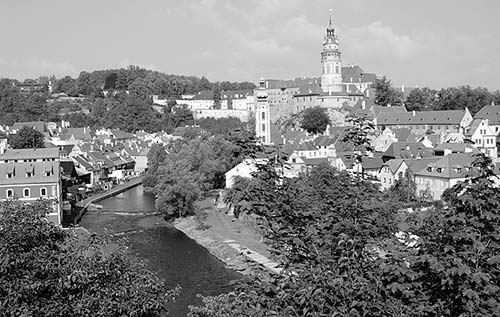
• Start at the bridge over the isthmus, which was once the fortified grand entry gate to the town (see map on here). For the best view, step down to the little terrace in front of the restaurant gate.
Horní Bridge: From this “Upper Bridge,” note the natural fortification provided by the tight bend in the river. Trace the river to your right, where it curves around the last building in town, with a smokestack. This is the Eggenberg Brewery, makers of Český Krumlov's very own hometown brew (with daily tours—see here). Behind that, on the horizon, is a pile of white apartment high-rises—built in the last decade of the communist era to solve a housing shortage (many homes were demolished after their German owners were forced out at the end of World War II—see sidebar). To the left of the brewery stands a huge monastery (with the pointy red steeple; not generally open to the public). Behind that, on Kleť Mountain—the highest hilltop—stands a TV tower and a world-class astronomical observatory and research center.
Head back up to the middle of the bridge. Look down and left, then down and right. Notice how the Vltava wraps entirely around the town center. Rafters take about a half-hour to circle around the Old Town peninsula, beginning and ending under this bridge.
• Head into town on...
Horní Street: As you step off the bridge, Český Krumlov's aptly named "Upper Street" passes the Museum of Regional History on the right (see here). Just past the museum, a little garden overlook affords a fine castle view.
Immediately across the street (on the left), notice the Renaissance facade of Hotel Růže: This former Jesuit college hides a beautiful courtyard, now filled with artistic vendor stands. Pop inside to shop or just admire its decoration of faux sgraffito “bricks,” made by scratching into an outer layer of one color of plaster to reveal a different color beneath. This style was all the rage during the town's boom time, and we'll be seeing several more examples on this walk.
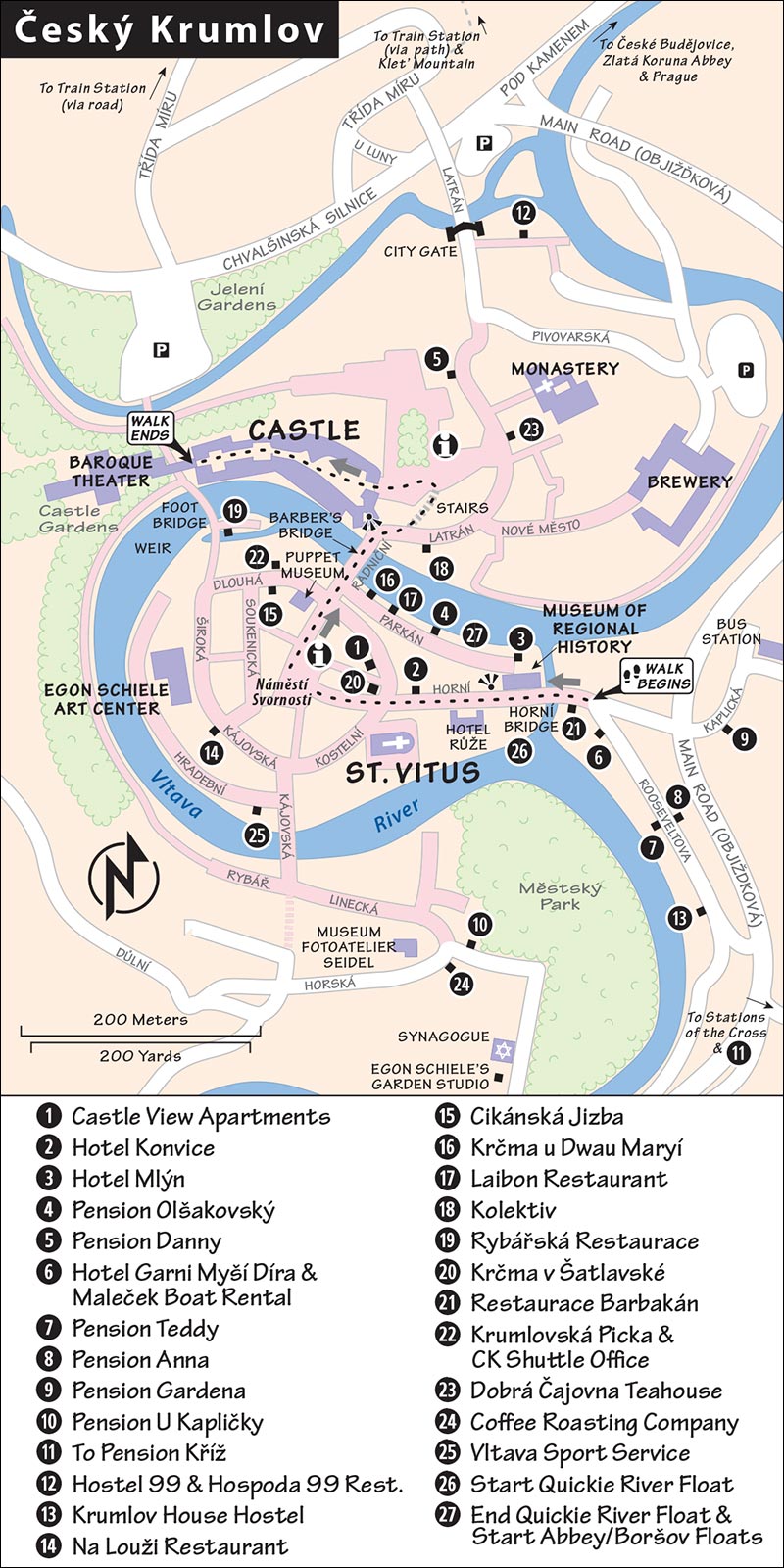
• Walk another block down the main drag, until you reach steps on the left leading to the...
Church of St. Vitus: Český Krumlov’s main church was built as a bastion of Catholicism in the 15th century, when the Roman Catholic Church was fighting the Hussites. The 17th-century Baroque high altar shows a totem of religious figures: the Virgin Mary (crowned in heaven); St. Vitus (above Mary); and, way up on top, St. Wenceslas, the patron saint of the Czech people—long considered their ambassador in heaven. The canopy in the back, though empty today, once supported a grand statue of a Rožmberk atop a horse. The statue originally stood at the high altar. (Too egotistical for Jesuits, it was later moved to the rear of the nave, and then lost for good.) Notice the empty organ case. While the main organ is out for restoration, the cute little circa-1716 Baroque beauty is getting plenty of use (photos of the restoration work on the far wall; generally open daily 8:30-16:30, Sunday Mass at 9:30, daily Mass at 17:00 in the winter chapel; tel. 724-937-121).
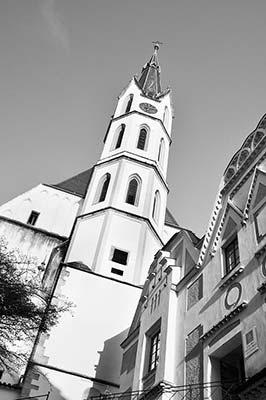
• Continuing on Horní street, you’ll come to the...
Main Square (Náměstí Svornosti): Lined with a mix of Renaissance and Baroque homes of burghers (all built on 12th-century Gothic foundations), the main square has a grand charm. The Town Hall (the crenellated white building, on the right) flies both the Czech flag and the town flag, which shows the rose symbol of the Rožmberk family, who ruled the town for 300 years.
Imagine the history that this square has seen: In the 1620s, the town was held by the (very Catholic) Habsburgs, just as Lutheran Protestantism was rising to threaten Catholic Europe. Krumlov was a seat of Jesuit power and learning, and the intellectuals of the Roman church allegedly burned books on this square. Later, when there was a bad harvest, locals blamed witches—and burned them, too. Every so often, terrible plagues rolled through the countryside. In a nearby village, all but two residents were killed by a plague.
But the plague stopped before devastating the people of Český Krumlov, and in 1715—as thanks to God—they built the plague monument that stands on the square today (on the left). Much later, in 1938, Hitler stood right here before a backdrop of long Nazi banners to celebrate the annexation of the Sudetenland. And in 1968, Russian tanks spun their angry treads on the roads to this square to intimidate locals who were demanding freedom. Today, thankfully, this square is part of an unprecedented time of peace and prosperity for the Czech people.
• From the main square, walk down Radničí street (on the right, just past the Town Hall) and cross the...
Barber’s Bridge (Lazebnický Most): This wooden bridge, decorated with two 19th-century statues, connects the Old Town and the Castle Town. On the right side stands a statue of St. John of Nepomuk, who’s also depicted by a prominent statue on Prague’s Charles Bridge. Among other responsibilities, he’s the protector against floods. In the great floods in August 2002, the angry river submerged the bridge (but removable banisters minimized the damage). Stains just above the windows of the adjacent building show how high the water rose.
• The second part of the walk involves lots of uphill hiking—but it's worth it to see the castle courtyards and dramatic views.
Big and imposing, the town castle boasts several fine courtyards, spectacular viewpoints, and gorgeous gardens—all of which are open to the public, free to enter, and fun to roam (though some areas may be closed on Mon). This part of the walk focuses on those public spaces, leading you from Barber’s Bridge, through the heart of the castle, and up to a picturesque viewpoint just before the gardens. The castle also has several individual sights (Round Tower, Castle Museum, Upper Castle, Baroque Theater) that can be laced into this walk but require paid admission and/or a reserved tour (for details, see listings under "Sights in Český Krumlov," later).
• Cross the bridge and head up shop-lined Latrán street, which bends to the right. Just after that bend, look for the stairs on your left (in front of the gray-and-white building). Head up, passing under a stone arch with the wood-carved rose symbol of the Rožmberk family. You'll emerge into the castle's...
First (Lower) Courtyard: This is just the first of many courtyards that bunny-hop up through the castle complex. This was the site for workers and industry (stables, smithy, brewery, pharmacy, and so on)—convenient for aristocratic needs, but far enough away to keep noises and smells at bay.
Looking up, you can't miss the strikingly colorful Round Tower that marks the location of the first castle, built here to guard the medieval river crossing. With its 16th-century Renaissance paint job colorfully restored, it looks exotic, featuring fancy astrological decor, terra-cotta symbols of the zodiac, and a fine arcade.
• Head up to the former drawbridge. Look over the sides of the bridge. Spot any bears?
Bear Pits (Medvědí Příkop): These hold a family of European brown bears, as they have since the Rožmberks added bears to their coat of arms in the 16th century to demonstrate their (fake) blood relation to the distinguished Italian Orsini family (whose name means “bear-like”). Featured on countless coats of arms, bears have long been totemic animals for Europeans. Pronouncing the animal’s real name was taboo in many cultures, and Czechs still refer to bears only indirectly. For example, in most Germanic languages the word “bear” is derived from “brown,” while the Slavic medvěd literally means “honey eater.”
Near the top of the bridge, notice the gently worded sign suggesting that—rather than toss down your junk-food leftovers—you add a few coins in the collection slot to finance "more varied meals and delicacies" for the bears.
• Continue through the gateway into the...
Second Courtyard: Here you’ll spot more of the sgraffito (Renaissance faux features scraped into wet plaster) that decorates much of the castle. To your left, at the bottom of the courtyard, is the entrance to the tower climb and the Castle Museum. Farther up on the left is the ticket office for castle tours, including the Baroque Theater—stop in now (if you haven't already) to see about a tour.
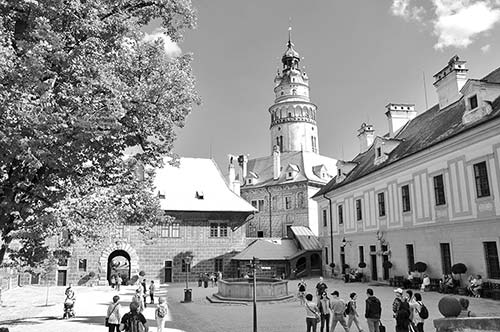
• From here, things get steep as we enter the...
Heart of the Castle Complex: Head up the bridge, noticing the little view terrace on the left—the first of several along here. You'll emerge into the Third Courtyard, then (after a corridor) the Fourth Courtyard. Nicely preserved paintings enliven their blocky facades. Wrapped around these courtyards is the castle proper, a mighty Renaissance building sometimes called the Upper Castle (interiors open to visitors—notice the meeting points for various tour options). Continuing straight out through the end of the Fourth Courtyard, you'll cross the breathtaking Cloak Bridge—a triple-decker, statue-lined, covered bridge spanning a vast gorge and connecting the castle firmly with the gardens that sprawl behind it. Enjoy the views—but believe it or not, even better ones are coming up.
Notice the Baroque Theater, at the far end of the bridge, which still uses traditional methods for moving scenery and producing sound effects. Aspects of this back-in-the-day stagecraft still survive on Broadway today. This is one of only two such original theaters in Europe.
• After the bridge, continue uphill through the...
Fifth Courtyard: Really more of a pathway, this connects the castle to its gardens. Walk along the white wall—with peekaboo windows—until you are almost at the gate up top. High on the wall to the right, notice the sundial. Check the time: It's dead-on...except for Daylight Savings Time, which was unknown to medieval timekeepers. Notice that the sundial cuts into one of the faux windows, painted on the lower level of the building to create Renaissance symmetry.
Now step through the low-profile door directly across from the sundial. You'll emerge at a spectacular viewpoint that takes in the entire town, its curving river, and even the colorful tower and most of the castle complex you just came through. Jockey your way through the selfie-snapping crowd and drink it in. (Or literally drink, at the little adjacent bar.)
• Our walk is finished. But if you still have stamina, you can consider exploring the castle gardens—they’re just uphill, through the gate from the Fifth Courtyard. (While the castle exterior is open all the time, the garden is open daily 8:00-19:00, with shorter hours off-season.)
KRUMLOV CASTLE COMPLEX (KRUMLOVSKÝ ZÁMEK)
▲Round Tower (Zâmecká Věž) and Castle Museum (Hradní Muzeum)
▲▲Baroque Theater (Zámecké Divadlo)
Castle Gardens (Zámecká Zahrada)
▲Seidel Photo Studio Museum (Museum Fotoatelier Seidel)
Museum of Regional History (Regionální Muzeum v Českém Krumlově)
▲▲▲Canoeing and Rafting the Vltava
Zlatá Koruna Abbey (Klášter Zlatá Koruna)
No Czech town is complete without a castle—and now that the nobles are gone, their mansions are open to us common folk. Český Krumlov is no different. Its immense Krumlov Castle complex, one of the largest in Central Europe, perches on a rock promontory overlooking the Vltava River and the town. The original Gothic castle took shape here in the 13th century, and eventually the Rožmberk, Eggenberg, and Schwarzenberg families each inherited it in turn. In successive waves of additions and renovations, they built it into the splendid Renaissance/Baroque property you see today.
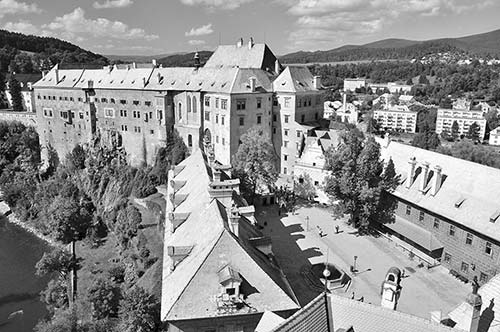
The following sights are listed in the order you'll reach them as you climb up through the complex (ideally following my self-guided walk, earlier). The Round Tower and Castle Museum can be visited at your leisure, while other castle interiors—including the excellent Baroque Theater—can only be seen with a guided tour (see next). On a quick visit, the only sight I'd bother paying admission for is the theater.
Reservations for Baroque Theater and Upper Castle: It’s worth the 10 Kč reservation fee to hold a slot on an English tour of the Upper Castle interior or the Baroque Theater (the theater is the castle attraction most likely to sell out). To book ahead, stop by the ticket office in person, or call 380-704-721 to check English tour times and reserve a space. No other castle sights require (or accept) reservations.
Information: Tel. 380-704-711, www.castle.ckrumlov.cz.
These two sights share a ticket office at the bottom of the castle's middle courtyard. While neither is a must, both are worth considering if you want a peek inside the castle without committing to a guided tour. These are also the only castle sights open on Mondays (in peak season).
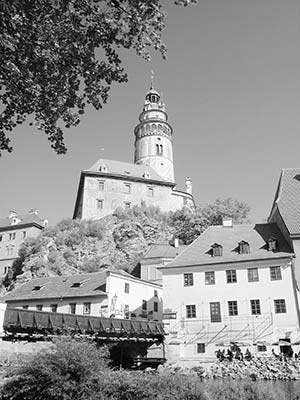
Colorfully impressive from the outside, the tower is also fun to climb. Twist up the 163 well-worn wood and stone steps to the top, where you'll be rewarded with grand, 360-degree views over the town, the rest of the castle complex, and happy boaters floating on the river.
The exhibits at the Castle Museum focus on key moments in the lives of the town’s various ruling families: Rožmberks, Eggenbergs, and Schwarzenbergs. Be sure to pick up the good, included audioguide as you enter. You'll see a hall of aristocratic portraits; the offices, bedrooms, and dining rooms of the various inhabitants; and a modest religious treasury, armory, and musical instruments collection. At the end you can sit in old-timey cinema seats and watch archival footage of the castle's residents from the 1920s and 1930s.
Cost and Hours: Tower-50 Kč, museum-100 Kč, combo-ticket for both-130 Kč; both open daily 9:00-17:00, June-Aug until 18:00, closed Mon in Nov-March; last entry one hour before closing.
While the Upper Castle grounds are free to explore, you’ll need to take a tour to access the interiors. Two different tour routes give you a glimpse of the places where the Rožmberks, Eggenbergs, and Schwarzenbergs dined, studied, worked, prayed, entertained, and slept. (By European standards, the castle’s not much, and the tours move slowly.) Imagine being an aristocratic guest here, riding the dukes’ assembly line of fine living: You’d promenade through a long series of elegant spaces and dine in the sumptuous dining hall before enjoying a concert in the Hall of Mirrors, which leads directly to the Baroque Theater (described next). After the play, you’d go out into the château garden for a fireworks finale.
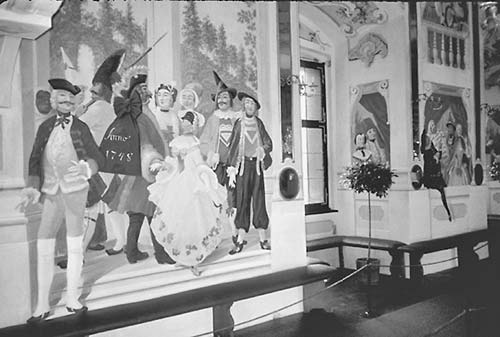
Cost and Hours: Choose from Tour I (Gothic and Renaissance rooms, of the most general interest) or Tour II (19th-century castle life). Tours run June-Aug Tue-Sun 9:00-12:00 & 13:00-18:00, spring and fall until 17:00, closed Mon and Nov-March. Tours in Czech cost 150 Kč, leave regularly, and include an adequate flier in English that contains about half the information imparted by the guide. English tours are preferable, but cost more (250 Kč), run less frequently, and are often booked solid. Pay to reserve a slot in advance; see “Reservations for Baroque Theater and Upper Castle,” earlier, for details. You’ll be issued a ticket with your tour time printed on it. Be in the correct courtyard at that time, or you’ll be locked out.
Europe once had several hundred Baroque theaters. Using candles for light and fireworks for special effects, most burned down. Today, only two survive in good shape and are open to tourists: one at Stockholm’s Drottningholm Palace; and one here, at Krumlov Castle. During the 45-minute tour, you’ll sit on benches in the theater and then go under the stage to see the wood-and-rope contraptions that enabled scenes to be scooted in and out within seconds (while fireworks and smoke blinded the audience). It’s a lovely little theater with an impressive 3-D effect that makes the stage look deeper than it really is, but don’t bother with the tour unless you can snare a spot on an English one. The theater is used only once a year for an actual performance, attended by Baroque theater enthusiasts.
Cost and Hours: 300 Kč for English tour, 250 Kč for Czech tour, tours Tue-Sun May-Oct, no tours Mon and Nov-April; English departures at 10:00, 11:00, 13:00, 14:00, and 15:00. Due to the theater’s fragility, groups are limited to 20 people, and English tours generally sell out. Reserve ahead—see “Reservations for Baroque Theater and Upper Castle,” earlier.
This lovely, 2,300-foot-long garden crowns the castle complex. It was laid out in the 17th century, when the noble family would have it lit with 22,000 oil lamps, torches, and candles for special occasions. The lower part is geometrical and symmetrical—French garden-style. The upper part is wilder—English garden-style. Both are delightful.
Cost and Hours: Free, open May-Sept Tue-Sun 8:00-19:00, April and Oct until 17:00, closed Mon and Nov-March.
This fully preserved, meticulously renovated 1905 Art Nouveau villa featuring original furnishings, a garden, and 100-year-old photo equipment offers a welcome respite from the crowds and the ubiquitous Middle Ages. The museum, set in the home and studio of Josef Seidel (1859-1935) and his son František (1908-1997), features more than 100,000 of their original photographs of life in this mountainous region—the Bőhmerwald (Bohemian Forest)—between 1880 and 1950. Josef Seidel was unique among his contemporaries in focusing on just one region, and was the first in the country to use autochrome. Allowed to remain in Český Krumlov during and after World War II when many Germans in the country were evicted (see sidebar on here), František continued his father's photography business, remaining here until his death in 1997. After his wife died in 2003, the town bought the house and converted it into a delightful museum and a cultural center for cross-border understanding. Restored, functional equipment offers hands-on experience with the process of photography during the late 19th and early 20th centuries. You can literally smell the history.
Cost and Hours: 130 Kč, includes English audioguide; daily May-Sept 9:00-18:00, shorter hours off-season; Linecká 272, across the river south of Old Town, mobile 736-503-871, www.seidel.cz.
Completed in 1910 in a mixture of architectural styles, this synagogue served the small Jewish community of Český Krumlov and neighboring villages. In 1938, there were 200 congregants here, but only two members of the area's Jewish community came back after World War II. Terribly run-down for decades after the war, the synagogue was restored to its former glory in 2015 by the Prague Jewish community, with funding from the European Union and German and Austrian sponsors. It contains an exhibit on its history, and hosts concerts and contemporary art exhibits.
Cost and Hours: 50 Kč, daily 10:00-18:00, Za Soudem 282, across the river south of Old Town, mobile 601-590-213, www.synagoga-krumlov.cz.
Eating: The $ Café Synagoga, with an assortment of cakes, occupies the former basement residence of the rabbi’s family and an adjacent peaceful garden.
This small museum gives you a quick look at regional costumes, tools, and traditions. When you pay, pick up the English translation of the displays (it also includes a lengthy history of Krumlov). Start on the top floor, where you’ll see a Bronze Age exhibit, old paintings, a glimpse of noble life, and a look at how the locals rafted lumber from the Bőhmerwald mountains all the way to Vienna (partly by canal). Don’t miss the fun-to-study ceramic model of Český Krumlov in 1800 (note the extravagant gardens high above the town). The lower floor comes with fine folk costumes and domestic art.
Cost and Hours: 50 Kč, Tue-Sun 9:00-12:00 & 12:30-17:00, July-Aug until 18:00, closed Mon, Horní 152, tel. 380-711-674, www.muzeumck.cz.
This may be one of the most intimate and accessible brewery tours in this land that so loves its beer. Tucked into a river bend on the edge of town, Eggenberg's spunky little brewery has an authenticity that can’t be matched by the big, soulless corporate breweries (such as Pilsner Urquell, in Plzeň, or the Czech Budweiser, in nearby České Budějovice). This is your chance to learn about the beer-making process at a facility where they're still using the same giant copper vats from 1915. While some of the facility has recently been modernized (and ongoing works may reroute the tour a bit), you'll still see lots of vintage equipment, including the original brew house (still in service), the fermentation vats, the cellars used for aging, and the bottling plant. Your tour ends with a visit to the pub, where you can sample some brews, including a "smoky" dark beer (Nakouřený Švihák), made with malt that tastes like salami, then aged for 100 days.
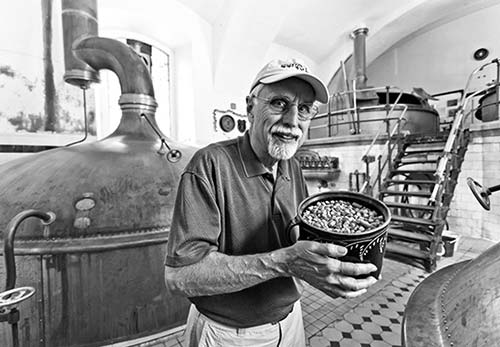
Cost and Hours: 100 Kč for the tour only, 130 Kč for tour and two tastes in the pub, 170 Kč for tour and four-pack of your choice of bottled beers to take away, 200 Kč includes everything; one-hour English tours daily at 11:00 year-round, also at 14:00 in May-Oct, tel. 380-711-426, www.eggenberg.cz.
Getting There: It's just a short stroll up Nové Město street from the main drag below the castle. During ongoing reconstruction, you may instead have to loop around town to the back entrance on Pivovarska—about a 10-minute walk.
Český Krumlov lies in the middle of a valley popular for canoeing, rafting, hiking, and horseback riding. Boat-rental places are convenient to the Old Town, and several hiking paths start right in town. Serious hikers should consider a hike up the mushroom- and blueberry-filled Kleť mountain.
Splash a little river fun into your visit by renting a rubber raft or fiberglass canoe for a quick 30-minute spin around Český Krumlov. Or go for a three-hour float and paddle through the Bohemian forests and villages of the nearby countryside. You’ll end up at Zlatá Koruna Abbey (described later), from where rafting companies will shuttle you back to town—or provide you with a bicycle to pedal back on your own along a bike path. This is a great hot-weather activity. Though the river is far from treacherous, be prepared to get wet.

You’ll encounter plenty of inviting pubs and cafés for breaks along the way. There’s a little whitewater, but the river is so shallow that if you tip, you can simply stand up and climb back in. (When that happens, pull the canoe up onto the bank to empty it, since you’ll never manage to pour the water out while still in the river.)
Choose from a kayak, a canoe (faster, less work, more likely to tip), an inflatable raft (harder rowing, slower, but very stable), or a retro-style raft made of logs. Prices are per boat (2-6 people) and include a map, a waterproof container, and transportation to or from the start and end points. Here are your options:
Quickie Circle-the-Town Float: The easiest half-hour experience is to float around the city’s peninsula, starting and ending on opposite sides of the tiny isthmus. Heck, you can do it twice (500 Kč for 2 people in a canoe or raft).
Three-Hour Float to Zlatá Koruna Abbey: This is your best basic trip, with pastoral scenery, a riverside pub about two hours down on the left, and a beautiful abbey as your destination (about 9 miles, 800 Kč for 2 people including pick-up). From there you can bike back or catch a shuttle bus home—simply arrange a return plan with the rental company.
Full-Day Float to Boršov: This takes you another four hours past the Zlatá Koruna Abbey, floating lazily through a pristine valley below the ruined Dívčí Kámen Castle (about 16 miles, 1,200 Kč for 2 people including pick-up).
Rental Companies: Several companies offer this lively activity. The handiest and also busiest are Půjčovna Lodí Maleček Boat Rental (long hours daily April-Oct, closed Nov-March, at recommended Pension Myší Díra, Rooseveltova 28, tel. 380-712-508, www.malecek.cz, lode@malecek.cz) and Vltava Sport Service (daily April-Sept 9:00-17:00, closed Oct-March, Hradební 60, tel. 380-711-988, www.ckvltava.cz). Expedicion offers similar services, plus airport transfers and car rental, with fewer crowds (Soukenická 33, mobile 720-107-171, http://expedicion.cz). Vltava and Expedicion also rent mountain bikes (300 Kč/day) and can bring a bike to the abbey for you to ride back.
For an easy 20-minute hike to the Křížový Vrch (Hill of the Cross), walk to the end of Rooseveltova street, cross at the traffic light, then head straight for the first (empty) chapel-like Station of the Cross. Turning right, it’s easy to navigate along successive Stations of the Cross until you reach the white church on the hill (closed), set in the middle of wild meadows. Looking down into the valley at the medieval city nestled within the S-shaped river, framed by the rising hills, it’s hard to imagine any town with a more powerful genius loci (spirit of the place). The view is best at sunset.
For a longer hike, start at the trailhead by the bear pits below the castle. Red-and-white trail markers guide you on an easy six-mile hike around the neighboring slopes and villages. The green-and-yellow stripes mark a five-mile hiking trail up Kleť Mountain—with an altitude gain of 1,800 feet. At the top, you’ll find the Kleť Observatory, the oldest observatory in the country (and still a leading astronomical center). On clear days, you can see the Alps (observatory tours-50 Kč, hourly July-Aug Tue-Sun 10:30-15:30, April-June Sat-Sun only, closed Sept-March and Mon year-round, www.hvezdarna.klet.cz).
Head about a mile out of town, beyond the Křížový Vrch (Hill of the Cross), for horseback rides and lessons at Slupenec Horseback Riding Club.
Cost and Hours: 300 Kč for one hour outdoors or in the ring, 2,200 Kč for all-day ride, Tue-Sun 10:00-15:00, closed Mon, helmets provided, Slupenec 1, worth a taxi trip, tel. 723-832-459, www.jk-slupenec.cz.
In recent years, Krumlov has become a shopping heaven, with a continuous line of gifts, toys, and handicrafts shops along its main street and spilling into the back alleys. The arts market in the renaissance courtyard of the Hotel Růže near the main square is the most scenic and fun to delve into.
This Cistercian abbey was founded in the 13th century by a Bohemian king to counter the growing influence of the Vítek family, the ancestors of the mighty Rožmberks. As you enter the grounds, notice the magnificent central linden tree, with its strange, cape-like leaves; it’s said to have been used by the anti-Catholic Hussites when they hanged the monks. The one-hour tour takes you through the rare two-storied Gothic Chapel of the Guardian Angel, the main church, and the cloister, while a 10-minute tour takes you to the abbot’s chapel with the original Gothic Zlatá Koruna Madonna, the most treasured painting in the region. After the order was dissolved in 1785, the abbey functioned briefly as a village school, before being turned into a factory during the Industrial Revolution. Damage from this period is visible on the cloister’s crumbling arches. The Gothic interiors adjacent to the ticket office serve as exhibition space for Český Krumlov’s school of the arts, displaying the imaginative creations of the school’s 6- to 18-year-old students (free).
Cost and Hours: 100 Kč—one-hour tour in Czech, generally runs every half-hour, pick up English leaflet; 20 Kč—10-minute Madonna tour, April-Oct Tue-Sun 9:00-16:00, June-Aug until 17:00, closed Mon and Nov-March, call 380-743-126 to arrange English tour, www.klaster-zlatakoruna.eu.
Getting There: Drivers can reach the abbey in about 10 minutes from Český Krumlov (head north out of town and follow route #39). But it’s more fun to get there by raft or canoe—the abbey is directly above the river at the end of a three-hour float (see “Canoeing and Rafting the Vltava,” earlier).
Krumlov is filled with small pensions and hostels. Summer is busy all around. While you can generally find a room in a modern pension in the outskirts upon arrival, book months ahead to stay in the heart of town.
$$$ Castle View Apartments rents seven diverse apartments. These are the best-equipped rooms I found in town—the bathroom floors are heated, all come with kitchenettes, and everything’s done just right. Their website describes each stylish apartment; the "view" ones really do come with eye-popping vistas (RS%, apartment sleeps up to 6, breakfast at a nearby hotel, Šatlavská 140, mobile 731-108-677, www.castleview.cz, info@castleview.cz).
$$ Hotel Konvice is run by a German couple—and their three children—with a personal touch. Each room is uniquely decorated (a block above the main square at Horní 144, tel. 380-711-611, www.boehmerwaldhotels.de, info@stadthotel-krummau.de).
Secluded Parkán street, which runs along the river below the square, has a hotel and a row of small pensions. These places have a family feel and views of the looming castle above.
$$$ Hotel Mlýn, at the end of Parkán, is a tastefully furnished hotel with more than 30 rooms and all the amenities (elevator, pay parking, Parkán 120, tel. 380-731-133, www.hotelmlyn.eu, info@hotelmlyn.eu).
$ Pension Olšakovský, which has a delightful breakfast area on a terrace next to the river, treats visitors as family guests (free parking, Parkán 114, mobile 604-430-181, www.olsakovsky.cz, info@olsakovsky.cz).
A quiet, cobbled pedestrian street (Latrán) runs below the castle just over the bridge from the Old Town. Lined with cute shops, it’s a 10-minute walk downhill from the train station.
$ Pension Danny is a funky little place, with homey rooms and a tangled floor plan above a restaurant (in-room breakfast, Latrán 72, tel. 603-210-572, www.pensiondanny.cz, recepce@pensiondanny.cz).
Rooseveltova street, midway between the bus station and the Old Town (a four-minute walk from either), is lined with several fine little places, each with easy, free parking. The key here is tranquility—the noisy bars of the town center are out of earshot.
$$ Hotel Garni Myší Díra (“Mouse Hole”) hides 11 bright and woody Bohemian contemporary rooms overlooking the Vltava River just outside the Old Town (prices include transfer to/from bus or train station, Rooseveltova 28, tel. 380-712-853, www.hotelmysidira.com). The no-nonsense reception, which closes at 20:00, runs the recommended boat rental company (Půjčovna Lodí Maleček, at the same address), along with a similar pension with comparable prices, Villa Margarita, farther along Rooseveltova.
$ Little Pension Teddy offers three deluxe rooms that share a balcony overlooking the river and have original 18th-century furniture. Or stay in one of four modern-style rooms, some of which also face the river (cash only, staff may be unhelpful, pay parking, Rooseveltova 38, tel. 777-713-277, mobile 724-003-981, www.pensionteddy.cz, info@pensionteddy.cz).
$ Pension Anna is well-run, with two doubles, six apartments, and a restful little garden. Its apartments are spacious suites, with a living room and stairs leading to the double-bedded loft. The upstairs rooms can get stuffy during the summer (pay parking, Rooseveltova 41, tel. 380-711-692, www.pensionanna-ck.cz, pension.anna@quick.cz). If you book a standard double and they bump you up to an apartment, don’t pay more than the double rate.
$ Pension Gardena has 16 spacious, airy rooms in two adjacent, tactfully renovated historical buildings. A family business with a garden, it’s on the way into town from the bus station just a hundred yards above Horní Bridge (Kaplická 21, tel. 380-711-028, mobile 607-873-974, www.pensiongardena.com, gardena@seznam.cz).
$ Pension U Kapličky, on a quiet street adjacent to a chapel and a city park, consists of two artistically designed apartments in an unusually-shaped medieval house. Jitka, a teacher of stone carving at the local arts academy and one of the last old-timers to still call central Český Krumlov home, lives downstairs and bakes pastries for breakfast (reserve months ahead, Linecká 60, mobile 606-434-090, www.ckrumlov.cz/ck/ukaplicky, ukaplicky@ckrumlov.cz).
$ Pension Kříž, with five rooms in a new, tastefully decorated house, is tucked away in a quiet, modern villa district under the Křížový Vrch (Hill of the Cross), just a five-minute walk from Horní Bridge (Křížová 71, mobile 775-421-012, www.penzion-kriz.cz, ubytovani@penzion-kriz.cz)
Of the hostels in town, Hostel 99 (closest to the train station) is clearly the high-energy, youthful party place. Krumlov House (closer to the bus station) is more mellow. Both are well-managed, and each is a five-minute walk from the main square.
¢ Hostel 99’s picnic-table terrace looks out on the Old Town. While the gentle sound of the river gurgles outside your window late at night, you’re more likely to hear a youthful international crowd having a great time. The hostel caters to its fun-loving young guests, offering a day-long river rafting and pub crawl, with a free keg of beer each Wednesday (private rooms available, laundry, use the lockers, no curfew or lockout, recommended Hospoda 99 restaurant, 10-minute downhill walk from train station or two bus stops to Spicak, Vezni 99, tel. 380-712-812, www.hostel99.cz, hostel99@hotmail.com).
¢ Krumlov House Hostel is take-your-shoes-off-at-the-door, shiny, hardwood-with-throw-rugs mellow. Efficiently run by a Canadian/American couple, it has a hip and trusting vibe and feels welcoming to travelers of any age (private rooms and apartments available, breakfast July-Aug only, well-stocked guest kitchen, laundry, Rooseveltova 68, tel. 380-711-935, www.krumlovhostel.com, info@krumlovhostel.com). The hostel sponsors “WriteAway,” a literary retreat for traveling writers (http://writeaway.literarybohemian.com).
(See “Český Krumlov” map, here.)
Krumlov, with a huge variety of creative little restaurants, is a fun place to eat. In peak season the good places fill up fast, so make reservations or eat early.
$$ Na Louži seems to be everyone’s favorite Czech bistro, with 40 seats (many at shared tables) in one 1930s-style room decorated with funky old advertisements. They serve good, inexpensive, unpretentious local cuisine and hometown Eggenberg beer on tap (daily 10:00-23:00, Kájovská 66, tel. 380-711-280).
$$ Cikánská Jizba (“Gypsy Pub”) is a Roma tavern filling one den-like, barrel-vaulted room. The Roma staff serves Slovak-style food (most of the Czech Republic’s Roma population came from Slovakia). While this rustic little restaurant—which packs its 10 tables under a mystic-feeling Gothic vault—won’t win any culinary awards, you never know what festive and musical activities will erupt, particularly on Friday nights, when Milan’s son’s band, Cindži Renta (“Wet Rag”), performs here (daily 13:00-24:00; off-season Mon-Sat 17:00-24:00, closed Sun; 2 blocks toward castle from main square at Dlouhá 31, tel. 380-717-585).
$$ Krčma u Dwau Maryí (“Tavern of the Two Marys”) is a characteristic old place with idyllic riverside picnic tables, serving ye olde Czech cuisine and drinks. The fascinating menu explains the history of the house and makes a good case that the food of the poor medieval Bohemians was tasty and varied. Buck up for buckwheat, millet, greasy meat, or the poor-man’s porridge (daily 11:00-23:00, Parkán 104, tel. 380-717-228).
$$ Laibon, while still a top choice for a filling vegetarian meal, has a chef who is evidently not inclined to calibrate her spices or rely exclusively on fresh ingredients (beware of canned pea soup). Settle down in the meditative inside or head out onto the castle-view river terrace and observe the raft-and-canoe action while you eat (daily 11:00-23:00, Parkán 105).
$$ Kolektiv tries to inject some modern sophistication into this olde town. It has a stark minimalist interior, a chalkboard menu, well-executed light café fare with some international flavors, a good cocktail selection, and stylish—if stuffy—service (daily 8:00-20:00, Fri-Sat until 21:00, Latrán 13, across from the castle stairs, tel. 776-626-644).
$$ Rybářská Restaurace (“Fisherman’s Restaurant”) doesn’t look particularly inviting from the outside, but this is the place in town to taste fresh carp and trout. Choose between indoor tables under fishnets or riverside picnic benches outside, and ask about their cheap daily specials that feed the floating Czech crowds (daily 11:00-22:00, on the island by the millwheel, mobile 723-829-089).
$$$ Krčma v Šatlavské is an old prison gone cozy, with an open fire, big wooden tables under a rustic old medieval vault, and tables outdoors on the pedestrian lane. It’s great for a late drink or roasted game (cooked on an open spit). Medovina is hot honey wine (daily 12:00-24:00, on Šatlavská, follow lane leading to the side from TI on main square, mobile 608-973-797).
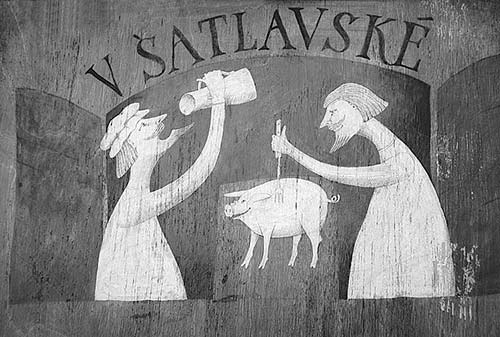
$$$ Restaurace Barbakán is built into the town fortifications, with a terrace hanging high over the river. It’s a good spot for old-fashioned Czech cooking and beer, at the top of town and near the recommended Rooseveltova street accommodations (open long hours daily, reasonable prices, Horní 26, tel. 380-712-679).
$$ Hospoda 99 Restaurace serves good, cheap soups, salads, and meals. It’s the choice of hostelers and locals alike for its hamburgers, vegetarian food, Czech dishes, and cheap booze (meals served 10:00-22:00, bar open until 24:00, at Hostel 99, Vezni 99, tel. 380-712-812). This place is booming until late, when everything else is hibernating.
$ Krumlovská Picka, a tiny, atmospheric place on the island by the millwheel, offers takeout pizza and freshly baked-and-filled baguettes. Cuddle near the oven inside or picnic on the outside terrace (daily 12:00-23:00, Dlouhá 97).
$ Dobrá Čajovna is a typical example of the quiet, exotic-feeling teahouses that flooded Czech towns in the 1990s as alternatives to smoky, raucous pubs. Though directly across from the castle entrance, it’s a world away from the tourist hubbub. As is so often the case, if you want to surround yourself with locals, don’t go to a traditional place...go ethnic. With its meditative karma inside and a peaceful terrace facing the monastery out back, it provides a relaxing break (daily 13:00-22:00, Latrán 54, mobile 777-654-744).
$ Coffee Roasting Company, on the corner of Linecká just past the Seidel Photo Studio Museum, is a tiny local place far away from the crowds and dead serious about the quality of its cakes and fair-trade brews (daily 10:00-19:00).
Almost all trains to and from Český Krumlov require a change in the city of České Budějovice, a transit hub just to the north. Buses, on the other hand, are direct. Bus and train timetables are available at www.idos.cz.
If you have time in České Budějovice between connections, consider a visit to the town’s gigantic medieval main square, Náměstí Přemysla Otakara II (about a six-block walk from the station). Store your bags in lockers at the train station, then exit the station to the right, cross the street at the crosswalk, and head straight down Lannova třida (which becomes Kanovnická street) to the square.
From Český Krumlov by Train to: České Budějovice (6/day, 45 minutes), Prague (8/day, 1/day direct, 3.5 hours; bus is faster and cheaper, but may be booked and doesn’t allow a stopover in Budějovice), Vienna (6/day with changes in Budějovice and Linz, 5 hours), Budapest (6/day with changes in Budějovice and Linz, 7 hours).
The Český Krumlov bus station, a five-minute walk out of town, is just a big parking lot with numbered stalls for various buses (bus info tel. 380-711-190). The Student Agency (www.studentagency.cz) and Leo Express (www.le.cz) have online reservation and ticket systems, the newest buses, and a free drink for passengers.

From Český Krumlov by Bus to: Prague (10/day, 3.5 hours; tickets can be bought at the Český Krumlov TI), České Budějovice (transit hub for other destinations; hourly, 40 minutes).
From Český Krumlov to Austria and Beyond: Several companies offer handy shuttle service. The best of the bunch is CK Shuttle, with free Wi-Fi on board and affordable fares: 800 Kč per person one-way to Vienna (4/day, 3.5 hours), Salzburg (4/day, 3 hours), Hallstatt (3/day, 3 hours), or Prague (3/day, 2.5 hours). They can also take you to Linz (where you can hop on the speedy east-west main rail line through Austria), Budapest, Munich, and other places. They offer door-to-door service to and from your hotel, and once you book on their website and receive a confirmation, your departure is guaranteed (office at Dlouhá 95, www.ckshuttle.cz). Another reliable option is Sebastian Tours (higher prices, mobile 607-100-234 or 608-357-581, www.sebastianck-tours.com, sebastiantours@hotmail.com).